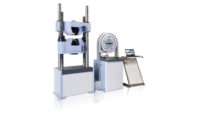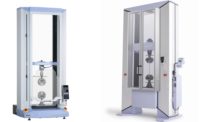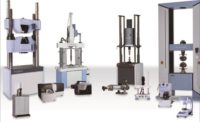All health care-related fields are growing, and the same is true for applications that test medical instruments and materials.
According to a study from Markets and Markets, the medical device testing market will reach $12.26 billion by 2023, growing at a rate of 6.2% from $8.6 billion in 2017.
The growth is mirrored in national spending on health care itself, which is projected to grow at an average rate of 5.5% per year through 2026, according to the U.S. Centers for Medicare and Medicaid Services, reaching $5.7 trillion that year.
Driven by an aging Baby Boomer population, health care spending as a percentage of the national gross domestic product will increase from 17.9% in 2016 to 19.7% by 2026, according to the U.S. government health agency. That far outstrips many other industries commonly associated with materials testing. The automotive industry, for example, has traditionally hovered around 3-4% of U.S. GDP, and the entire manufacturing economy’s share of GDP is currently about 12%. Energy accounted for about 5.6% of GDP in 2016, according to the U.S. Energy Information Administration.
Medical Equipment Testing Categories
Quality is important for any product, but defects in medical devices can have immediate life or death consequences. Just about everything is classified by the risk of a defect occurring, including general medical equipment like scalpels, scissors, and X-ray film.
That’s in addition to external diagnostic tools such as blood analysis equipment; controlled medical equipment including catheters for the gastrointestinal tract, dental alloys and electronic endoscopes; and specially controlled medical equipment including orthopedic implants, balloon catheters, contact lenses and stent grafts, according to Shimadzu.
“Medical equipment manufacturers implement a variety of evaluations to ensure the functionality, performance, and safety of their products,” according to information provided by Shimadzu. “The assessment of strength properties through physical testing is one such important item. Evaluation of the mechanical properties of variously shaped medical equipment requires the use of jigs suited to each piece of equipment.”
Shimadzu offers a variety of practical testing equipment for these purposes.
→ Mechanical Evaluation of Injection Needles and Injectors
Pharmaceutical manufacturers measure the force required to inject liquids from needles and syringes. Tests ensure that the force exerted by the plunger stays within a suitable range.
In these tests, “in addition to collecting data on extrusion force versus time, it is also necessary to measure the average test force value and the peak test force at specific positions of plunger displacement,” according to Shimadzu. “Such values are significantly affected by the material from which the injector is constructed, as well as sterilization treatments, and the viscosity of the medical liquid.”
→ Three-Point Bending Testing of Ampoules
Ampoules are sealed glass capsules containing measured quantities of liquids for injecting. It’s important that ampoules and other injectable drug and liquid containers are sterilized, and while glass ampoules are common, the use of plastic versions has increased.
Those plastic ampoules must be tested for strength properties because it has an effect on both the storage of the medical liquids, in addition to transportation and handling. Ampoule breakage strength is measured by bending tests.
“Vials are subjected to compression tests, and vial stoppers are subjected to needle penetration tests,” according to Shimadzu. “In such tests, it is important to use test jigs suited to the sample.”
→ Strength Testing of Injection Needles
Engineers perform a variety of tests to inspect the mechanical properties of injection needles.
“In elasticity tests, a cantilever force is applied to the needle for one minute to evaluate whether the needle returns to the horizontal position,” according to Shimadzu. “In bending tests, the center of the needle shaft is bent 90 degrees to examine whether it breaks. In pulling tests, the needle is pulled out from its base.”
→ Evaluating the Mechanical Properties of Contact Lenses
Contacts are now more popular than glasses. The lenses are tested for tensile and compression strength to ensure they can withstand daily use.
“Soft contact lens material slips easily, is delicate, and is damaged by very small forces,” according to Shimadzu. “When performing contact lens tensile tests, the sample grip method and the limited grip area can cause problems. When testing in air, the material may dry and crack, so contact lens tests are performed in environments simulating physiological conditions.”
→ Mechanical Evaluation of Medical Equipment Categories
Metals, plastics, films, resins, textiles and other materials are all used in medical devices. Use depends on the environment. Some are sterilized, some aren’t. Some may be used repeatedly and others may only be used once and then thrown away.
Shimadzu offers a universal table top tester than can be used to test the wide range of medical materials, for applications ranging from research and development to quality control.
→ Tensile Testing of Surgical Tubes
The shapes and sizes of surgical tubes vary along with applications, whether they are used for drainage, liquid delivery, or injections. Different connectors and accessories come along with the variety of tubes.
Determining the mechanical properties of surgical tubes is extremely important to prevent defects that could put a patient at risk.
Test requirements involve “material defects, junction defects, and physiological parameter simulations,” according to Shimadzu. “To this end, material/final product tensile strength, durability and friction properties are measured.
“Regardless of the test application, in order to obtain accurate measurement values, it is important that the tube is suitably gripped. This applies both to the evaluation of the mechanical properties of surgical tubes themselves and to evaluations of the connection strength between tubes and accessories.”
→ Tensile Testing of Catheters
Hollow, flexible catheters are inserted for a variety of medical purposes. They are often placed into body cavities, the gastrointestinal tract, ducts and blood vessels. Once inserted, they eliminate bodily fluids, or inject or drip liquid medicines. They can also deliver medical stents, balloons, and other devices into the body.
“The operability of catheters is significantly affected by their mechanical properties, such as a lack of intra-tubular flexion, and whether torsion is accurately transmitted in order to change direction via guide wires,” according to Shimadzu. “Tensile tests are typically performed, where pneumatic grips are recommended to grip samples accurately. Even samples that become thinner as tension is applied can be accurately gripped all the way to the breakage point.”
→ Tensile Testing of Bandages and Textile Materials
Tensile materials are used for bandages or moisture-absorbent cotton.
“For this reason, a suitable tensile strength is required, and the bandage must be elastic enough to compress the affected part and to hold other medical instruments in place,” according to Shimadzu. “Individual fibers can be tested at constant test conditions by using capstan type grips (also used for tensile tests of hair) to maintain a uniform clamping pressure while preventing the application of unnecessary force.”
→ Tensile Testing of Silicon Rubber and Other Soft Materials
Rubbers and thin resin materials are used in therapeutic applications. Using a video extensometer, engineers can find accurate extension measurements in tensile tests of soft stretchable samples.
“Since extension is measured without contact, displacement is measured accurately all the way to the breakage point, without being subjected to unnecessary loads,” according to Shimadzu. “Measurements of displacement in the width direction are also possible.”




